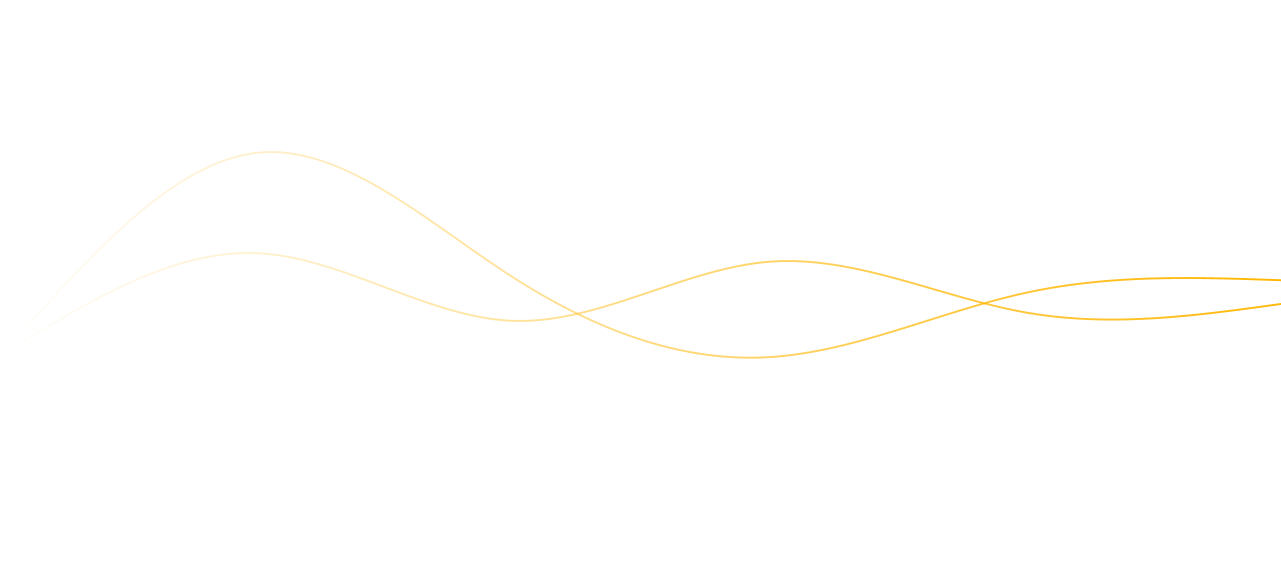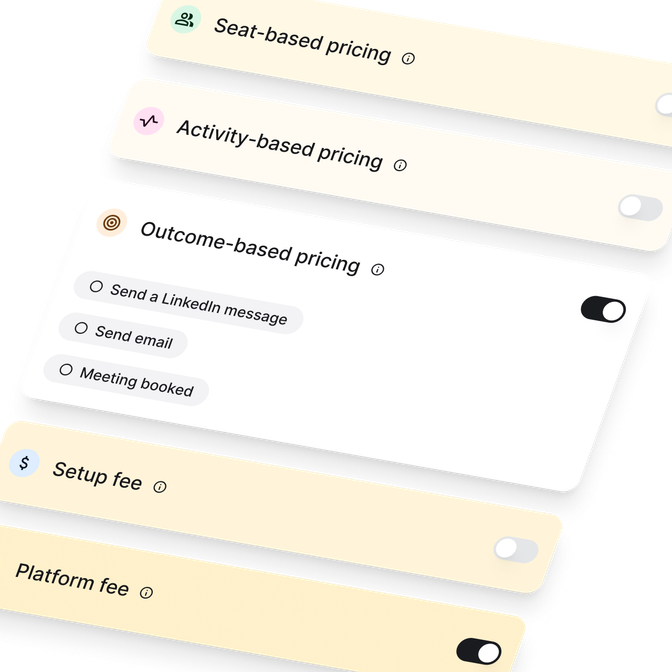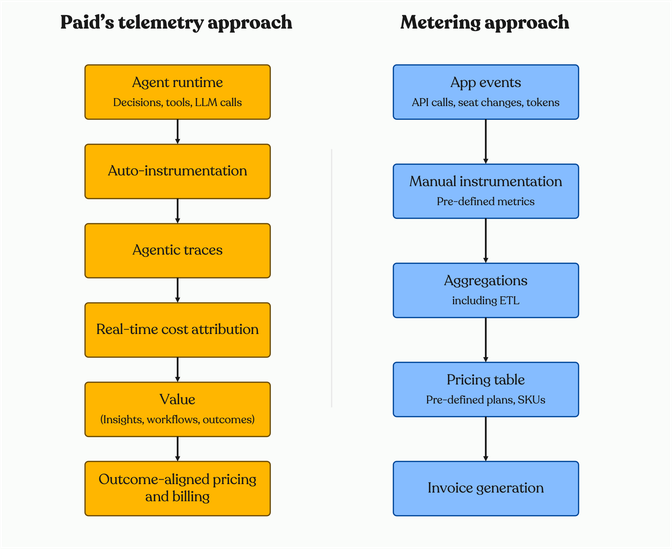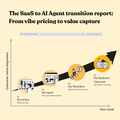Build agents and get paid
Understand your margins and get paid for the value your agents create.



Sales teams are replacing BDRs with AI agents - specifically AI SDRs, which have cropped up like mushrooms in fall.
These AI SDR agents prospect leads, write outreach sequences, book meetings, and manage entire outbound pipelines. The technology works.
The challenge isn't so much in building the AI SDR, but rather charging for work that never stops.
When you're selling AI-powered sales development tools, "our agent sends emails" doesn't justify enterprise pricing. Sales leaders want pipeline metrics. CFOs need cost-per-meeting numbers. Revenue teams want to know if the AI outperforms human BDRs. You need to prove value in terms sales organizations already measure.
This creates a billing problem traditional sales software never faced.
Most sales development platforms use seat-based pricing inherited from CRM and email automation tools. You charge per user or per sales rep accessing the platform. This made sense when software waited for humans to click send.
AI SDRs don't work that way.
Your agent might research 500 prospects per day. It writes personalized outreach, manages follow-up sequences, responds to replies, and books meetings automatically. The work happens continuously. A single "seat" can handle the workload of an entire BDR team.
But your billing system treats all of this like a $100/month user license.
This disconnect creates three problems:
Massive underpricing: When your AI SDR books 50 qualified meetings per month, charging $2,000 feels absurd compared to the $60,000 annual cost of hiring a human BDR who books 20 meetings.
Unclear value: Your customers can't see what the agent accomplishes. Without measurement, they compare your pricing to traditional email automation tools. "Why pay $10,000 when Outreach costs $1,000?" becomes a deal killer.
Broken unit economics: Running AI SDRs costs real money. LLM calls for personalization, data enrichment APIs, email infrastructure. If you don't track costs per customer, your best customers subsidize your worst. You scale revenue while margins collapse.
Standard billing platforms can't solve these problems because they weren't built for products that replace entire job functions.
Sales development companies moving to AI-powered prospecting need three capabilities their current billing stack doesn't provide:
Outcome tracking: Measure business results, not email volume. Track meetings booked, qualified conversations started, pipeline generated. The metrics sales leaders report to their board.
Value attribution: Connect agent actions to revenue impact. When your AI books a meeting that turns into a $50,000 deal, you can calculate precise ROI per interaction. When it sends 1,000 emails that generate zero pipeline, you know which campaigns need optimization.
Flexible pricing models: Move beyond seats to performance-based models. Charge per meeting booked. Take a percentage of influenced pipeline. Combine base fees with success bonuses. Models that align your pricing with customer success.
Companies building AI-powered sales development tools are solving this with outcome-based infrastructure instead of usage-based billing.
Here's how it works:
Track what matters to sales leaders: Instead of counting emails sent or API calls made, track completion of sales workflows. Meetings booked with qualified prospects. Opportunities created. Pipeline influenced. Response rates achieved. The metrics sales teams already report to leadership.
Connect to existing CRM data: The best measurement strategies don't require new systems. They plug into data you already have. If prospects are in Salesforce and meetings sync to calendars, you're already tracking outcomes. Connect that to agent activity and ROI calculation becomes straightforward.
Show value continuously: Don't wait for monthly business reviews to prove impact. Embed live dashboards showing agent performance, meetings booked, response rates. Make the invisible prospecting work visible in terms sales teams understand.
One well-known AI SDR built an agent that handles the entire outbound function. The agent finds leads, enriches contact data, writes personalized sequences, and books meetings with qualified prospects.
While they did use seat-based pricing initially, their agent didn't occupy a seat for real - it works continuously and handles workload equivalent to multiple human BDRs.
Eventually they realized they needed to:
"Customers see exactly what the agent delivers. Transparent value tracking makes renewals straightforward. When you can show 200 qualified meetings booked, the ROI justifies renewal."
- AI SDR customer
Legacy billing platforms couldn't do this. In particular, they were built for software subscriptions, not autonomous agents.
The AI SDR vendor integrated Paid's AI-native billing platform to handle four critical pieces:

The results changed their business:
Retention improved: Customers see exactly what the agent delivers. Transparent value tracking makes renewals straightforward. When you can show 200 qualified meetings booked, the ROI justifies renewal.
Pricing became defensible: When a single agent books 50 meetings per month at $250 per meeting, the $12,500 monthly cost makes sense. Compare that to a $5,000/month human BDR who books 20 meetings.
Operations simplified: As agent performance improves, they capture more value automatically. Better outcomes mean higher revenue without changing the pricing model. No contract renegotiations needed.
Traditional seat-based pricing doesn't match how sales development AI actually delivers value. Three models work better:
Model | Structure | Best For | Customer Predictability | Revenue Capture |
|---|---|---|---|---|
Per-outcome | $200 per meeting booked | High-volume, proven targeting | Low (varies with performance) | Highest (scales with value) |
Hybrid | $3k base + $200/meeting | Mid-market, steady pipeline | Medium (known minimum) | Balanced |
Pipeline sharing | 3-5% of influenced pipeline | Enterprise, long sales cycles | Low (depends on close rates) | Variable (high upside) |
With per-outcome pricing, you charge per meeting booked ($100-500 depending on industry and deal size), per qualified conversation started, or per opportunity created. Customers only pay for results.
With the hybrid model, you charge a ase platform fee ($3,000/month) plus performance fees ($200 per meeting booked). Provides predictable minimum revenue while scaling with customer success.
With pipeline sharing, you agree with your customer to charge a percentage of influenced pipeline (3-5%) with monthly minimums and caps. Aligns incentives completely but requires deeper CRM integration and attribution tracking across the flow.
The best pricing strategy depends on what you can measure reliably and what your customers already track. If your platform integrates with their CRM, pipeline-based pricing becomes feasible. If not, start with per-meeting pricing and evolve as your measurement improves.
Here's what makes AI sales development different from traditional sales software:
Factor | Human BDR | AI SDR | Billing Implication |
|---|---|---|---|
Work schedule | 40 hrs/week, PTO, sick days | 24/7/365 continuous | Seat pricing undervalues by 4x |
Cost structure | Salary, benefits, equipment | API calls, compute, data enrichment | Variable costs require margins tracking |
Decision making | Takes direction, needs management | Autonomous targeting and sequencing | Pricing should reflect job replacement |
Performance curve | Flat after training | Improves continuously with data | Pricing should capture improvement |
Most billing platforms used by sales technology companies were built for traditional SaaS. They handle seats, usage tiers, and subscription management well.
They can't track what an AI SDR does. They can't measure the value a prospecting workflow delivers. They can't price based on outcomes because they weren't designed for products that replace entire teams.
Companies building AI-powered sales tools need different, AI-native infrastructure like Paid, with:

If you're building AI-powered sales development technology, you face a measurement challenge that becomes a pricing challenge that becomes a growth challenge.
Your agent delivers real value. You need to prove it, price for it, and show it continuously to customers.
These are the steps you must take if you're building an AI SDR:
The AI SDR companies that figure out how to measure and monetize outcomes will dominate their categories. The ones that stick with seat-based pricing will struggle to justify their value as costs scale with usage.
Your agent works. Now it's your job to make sure you can prove it and charge for it (and Paid is here to help make that happen)
Building AI for sales development? Learn how AI-native billing infrastructure helps you track costs, prove ROI, and move to outcome-based pricing. Start with free cost tracking or book a demo to discuss your specific needs.
Understand your margins and get paid for the value your agents create.




Price smarter. Protect margins. Grow revenue.